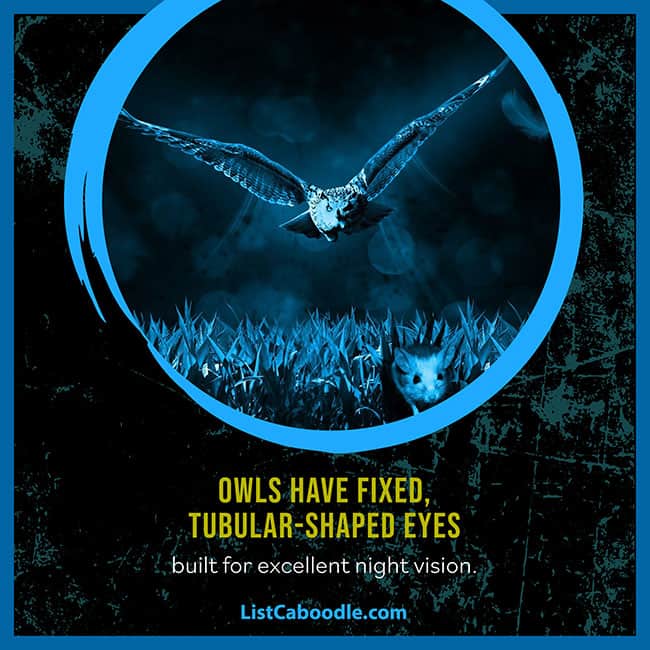The Amazing Superpowers of Owls
Owls are known as reclusive masters of the night, silently keeping watch over woods and forests.
Long admired for their intelligence and predatory ability, the wise old owl is a favorite among birders and nature-lovers alike.
8 wondrous abilities of owls
You’ve probably passed below an owl perched in a tree without even knowing it. The superpowers of these gifted predators are amazing—their silent flight, powerful hunting and tracking skills, and remarkable stealth.
Here is a list of the most mind-blowing abilities of owls.
1. Owls have keen eyesight

The unique structure of an owl’s eyes gives it excellent vision. Owls have large eyeballs that are fixed in their eye sockets. Plus the eyes are forward-facing, unlike most birds of prey that have eyes on either side of the head. This binocular vision allows for greater depth perception when an owl is stalking prey.
Since the eyes of an owl are fixed in position, they aren’t able to move around within the sockets. Instead, an owl moves its head to track objects in space.
2. And also have great night vision

Most owls are nocturnal, meaning they are active at night and use the darkness for cover in hunting prey. Unlike bats, they do not use echolocation. Instead, owls rely on their binocular vision for depth perception and night vision.
The owl’s large eyes are not true ‘eyeballs.’ Instead of being round, their eyes are tubular-shaped, providing excellent night vision. A high density of rod cells in the retinas of the eyes help to improve vision in low-light conditions. Therefore, very little light is needed for an owl to navigate and hunt in densely-packed wooded areas.
Did you know: An owl’s night vision is 100 times better than humans.
3. Owls are built for precision hearing

The owl’s highly-developed hearing abilities come from its round, concave areas around the eyes and its asymmetrically-placed ears on the sides of its head.
Facial feathers form discs similar to a satellite dish around each of the owl’s eyes. This unique feather structure focuses and directs sound to the ear openings on each side of its head.
Asymmetrical hearing allows the owl to locate prey with great accuracy. Because sound travels to each ear at different times, the owl can pinpoint the direction the sound is coming from, whether its prey is in front or behind it, above or below it, or left or right of it. In a split second, the owl determines where the sound is coming from with extreme accuracy, usually in complete darkness.
These factors give the owl a hearing ability that is 10-times greater than humans.
Did you know: Some owls have other hearing adaptations, like a flap of skin in front of their ears, allowing them to hear sounds differently from front to back.
4. They are capable of nearly silent flight

The owl has another superpower that separates it from most other predators—the ability to soar silently through the night sky, seeing and hearing any movement of its prey below.
This nearly silent flight is achieved because the owl’s flight feathers reduce air turbulence and thus reduce sound. The comb-like outer edge of these feathers differentiates the owl from other raptors. The resulting effect muffles sound, with less rippling of the edge feathers in flight.
Also, the surface of the owl’s flight feathers has a velvety covering that traps air within the feather’s surface, smoothing the air-flow across the wings. The sound that remains falls below the hearing spectrum of the owl’s usual prey but within the owl’s natural range.
One disadvantage to the sound-dampening qualities of these feathers is that they do not work when wet. So an owl can’t hunt very well in the rain. Owls lack natural waterproofing like other bird species. This may also cause owls to struggle to keep warm when their feathers are wet.
VIDEO: How owls fly so silently
5. Which makes them a stealth predator

The owl’s hunting prowess comes largely from its strategy of stealth and surprise. With its hawk-like beak and sharp talons, an owl is able to grip and tear at its prey. The talons are zygodactyl, meaning they have two forward-facing toes and two backward-facing toes.
These carnivores hunt small mammals like mice, rabbits, and squirrels, as well as other birds and insects. Some species of owls are even known to eat fish.
Owls are solitary hunters that don’t need to see their prey. Even if a mouse is hidden under a blanket of snow, the owl can hear it moving over 300 yards away.
Once the owl has its prey in hand, its sensitive feet are able to feel it by way of filoplumes, or hairlike feathers. When the prey is subdued, it uses its powerful beak and talons to kill the mouse and swallow it whole.
Check out these inspiring owl quotes and sayings.
6. Owls have almost 360 head rotation

It may seem like owls can rotate their heads 360 degrees but in reality, they can rotate their head and neck up to 270 degrees, which is really quite incredible!
Owls have twice the number of neck vertebrae as humans (14 in owls vs. 7 in humans). The extra vertebrae allow the owl to rotate and twist its head to look around the environment and track prey. Its circulatory system is adapted so that blood flows to the brain even at extreme head angles. This allows the owl to maintain stealthy silence, reducing body movement on its perch.
Did you know: Owls sleep during daylight hours.
7. They are hard to spot in the wild

It’s hard to spot an owl in the woods unless it gives itself up by letting out a ‘hoot, hoot’ sound. These masters of camouflage have plumage that is colored to blend in with the natural environment, making them nearly invisible to see.
Most owl color patterns mimic their surroundings, but there are exceptions. The Barn Owl has white feathers on its face and underbody. It’s possible this may work to hide the bird’s silhouette in flight.
VIDEO: How to identify owls by their calls
More fun facts about owls
1.) Over 200 owl species are found worldwide except at the polar ice caps and on some remote islands.
2.) Although most owls are largely solitary creatures and don’t roost communally, a group of owls is called a parliament. The term originates from C.S. Lewis’ novel The Chronicles of Narnia, in which he describes a gathering of owls.
3.) Owls are farsighted. They do not see things immediately in front of them very well.
4.) The smallest owl, the Elf Owl, weighs just under two ounces and measures 5.25 inches tall. The largest owl in North America is the Great Gray Owl at 32 inches tall.
5.) Owls have a lightweight body for easier flight. Their skeletons makes up only 7-9 % of their entire body weight. Some of the owl’s larger bones are hollow, which helps reduce overall weight.
6.) Male and female owls are usually not the same size. The female is typically larger than the male.
7.) Owls regurgitate the indigestible parts of their prey in the form of pellets. Owl pellets can often be found at the base of a tree below the owl’s roosting spot.
8.) The two “ears” above the Great Horned Owl’s head are merely feather tufts. Its ears are on the sides of its head.
Thank you for reading about the incredible superpowers of owls. Be sure to check out these other interesting lists about birds and animals:
The Mysterious Crow: Facts & Figures
All the State Birds List
By Greg Johnson | Published 12/30/2020